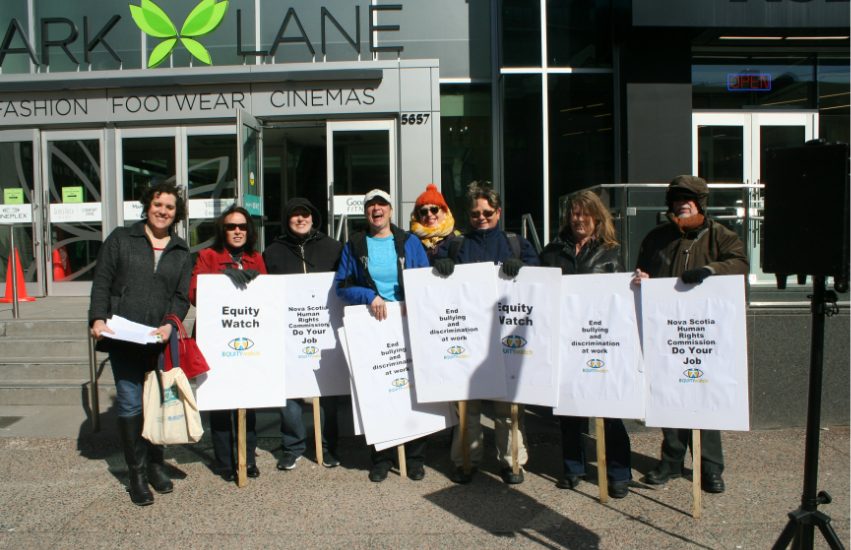
KJIPUKTUK (Halifax) – Earlier this week we reported how Equity Watch calls for major structural changes to the Nova Scotia Human Rights Commission to deal with the many complaints about its fairness and timeliness that have been raised over the years.
We also published the transcribed remarks by Liane Tessier and Connor Smithers-Mapp. The final speaker at the virtual report launch was Larry Haiven, who summarized some of the report’s recommendations. Here are his remarks.
I’m going to continue with some of our criticisms. I’m going to tell you about the Ontario system that has a lot to recommend it, and touch on some of our 25 or so recommendations.
Self-representation
The first thing I want to talk about is self-representation. Complainants are well advised to have legal counsel, even from the start of a complaint at the Human Rights Commission, but they do so at their own expense. Also, at Boards of Inquiry, the Commission’s lawyers do not act for them. Boards of Inquiry are more relaxed than the courts, and it’s possible for people to represent themselves, but they do follow the rules of courtroom procedure and frequently issues of some legal complexity arise.
A recent case, just last month, is that of Gyasi Symonds, an African Nova Scotian man. He claimed that Halifax police officers treated him over-aggressively and did not act in a similar fashion with white people doing exactly the same thing. Though he was very competent in directing his own case last month, Symonds was not a trained lawyer. And he was faced with a bevy of lawyers representing all of the other parties, including the adjudicator. He himself pointed out that all of those attending the hearing were being paid for their time and services except for him. In those hearings there was a complex argument to be made about systemic discrimination, that required legal training and research. The Commission’s legal team could have made that argument more forcefully, but did not. And Symonds could hardly have been expected to do so. You’ll see in a moment what we recommend.
Restorative justice
The second thing I want to talk about is restorative justice. Our Human Rights Commission is noted for its extensive use of so called restorative justice. This approach emerged from reforms in the criminal carceral regime over the past 30 years. Sounds laudable in theory, but a solution meant to keep relatively powerless and disadvantaged offenders out of jail in the criminal system may not be totally appropriate in a human rights setting, where offenders are often privileged and powerful employers, landlords or business owners. In our report, we go through several complaints about this approach, and recommend that the Commission’s use of it is due for a thorough and honest review.
Non-disclosure agreements
I want to talk about non-disclosure agreements, which are basically gag orders. Of the few complaints finally accepted by the Nova Scotia Human Rights Commission close to one third are settled by private agreement among the parties. Respondents, e.g. the perpetrators, usually demand and get a nondisclosure agreement or gag order, wherein complainants promise they will disclose nothing about the terms of the settlement.
If two of the main purposes of a human rights regime are public education and general deterrence, then a gag order renders the settlement route absolutely useless. We need look only at the Harvey Weinstein case in the United States to see the damage that non disclosure agreements can do to the public interest.
Expanding prohibited grounds of discrimination
I also want to talk about expanding prohibited grounds of discrimination. These grounds differ among the Canadian jurisdictions. But there are blatant causes of discrimination that have evaded justice for far too long. And it’s been it’s been 20 years at least, since there’s been a major review of the grounds of discrimination. But here are two of them that I could point to. One is body size. Unless you’re also discriminating on the basis of race or sex or religion, body size is excluded. Bullying also, again, unless the bullying is done on some other prohibited ground, is not covered at all and desperately needs review. And we need much more flexibility in the grounds of discrimination that come before the Human Rights Commission.
The Ontario model
Now, I want to talk as briefly as possible, but we do go into it in great detail in our report, about the Ontario model.
Our human rights regime cries out for change. We are fed up. Therefore we’re compelled to look to alternative models in Canada. Such an alternative exists in Ontario for 16 years. It’s a tripartite system with a clear division among three different agencies, a Human Rights Commission, a tribunal, and human rights legal support center. It was brought in precisely because of the problems similar to those present in Nova Scotia. And we talk in the report about the Pinto report, which I would recommend that people read.
A warning, the tripartite model comes as a package. It works only if all three agencies exist, and if they’re properly resourced. You can’t take away the Human Rights Commission and just have a direct access tribunal. And you can’t just have the tribunal without a legal support center.
So just looking into these three agencies briefly, the the Human Rights Commission in Ontario does not screen complaints of discrimination. It’s restricted to policy matters, public education and research. It does have the power to act on its own initiative to bring forward complex issues like systemic discrimination, and racial profiling.
The Human Rights Tribunal is a permanent (entity), as opposed to Nova Scotia where it’s ad hoc. It’s a permanent direct-access body that processes and hears complaints. Obviously it tries to mediate and get settlements, but there’s one big innovation. The Ontario Human Rights Code provides that no complainant is denied access to a so-called day in court of some sort, if that is what they wish. That day in court may be as short as a summary hearing, or it could be a full inquiry.
And finally, the legal support center, which offers legal advice to applicants, and assists them in framing their complaints. It operates separate from the legal aid system, and does not apply means tests.
Some of the recommendations
I just want to move very quickly through some of our recommendations.
We are recommending that Nova Scotia move to a tripartite system similar to that in Ontario, with distinct agencies. (We recommend) that these agencies be properly resourced, that they report directly to the legislature and not to the Minister of Justice. And we go into some lengths to explain why the system now is too politicized. It’s the Minister of Justice that accepts a report and it should be given to the legislature as a whole.
We want clear service delivery standards and time limits, including length of investigations, similar to what Connor mentioned.
There should be no non-disclosure agreements except at the wish of the complainant.
We want less reliance on restorative justice, especially where power and resources are tilted towards the perpetrators or respondents. We recommend a move away from passive diversity and inclusion models of remediation toward more activist approaches.
We want the time limits for complainants to the tribunal opened up to three years because of the trauma that Connor mentioned.
We want a citizen’s review Board, independent of the Human Rights Commission, which would include representatives of equity seeking groups. And included in its mandate would be monitoring progress on any set of remedial measures, ordered by the tribunal or agreed to by settlement. In other words, Leanne mentioned the fact that her employers, the fire service and HRM, made six promises to the people of Nova Scotia and to her, and we cannot find out what the progress of those are.
And finally, as Connor mentioned and I don’t need to go into more detail, (we need) a much more activist approach on the part of the Commission, a Commission that is actually getting out there and not waiting for complaints to come through the door, but actually doing some research based on statistics and investigations.
Thank you.
With a special thanks to our generous donors who make publication of the Nova Scotia Advocate possible.
Subscribe to the Nova Scotia Advocate weekly digest and never miss an article again. It’s free!




I have a case pending with the NSHRC. It has moved through the system at a snail’s pace. In the initial
proceedings they were reluctant to address the case because of who I was making the case against. I
had to point out very clearly that my case fell within their mandated jurisdiction. I had to hire a lawyer
at great expense to formalize and initiate my case before the commission. Although, I could have easily
done the same thing but rather have some legal perspective to my case. They tried to dance around my
case BUT had no choice but to accept it. PS: They realized I knew the procedure(s) from my previous work
(internship) with the agency.
I applaud the new initiatives and fully understand the frustration many face when dealing with issues of importance
in their lives.